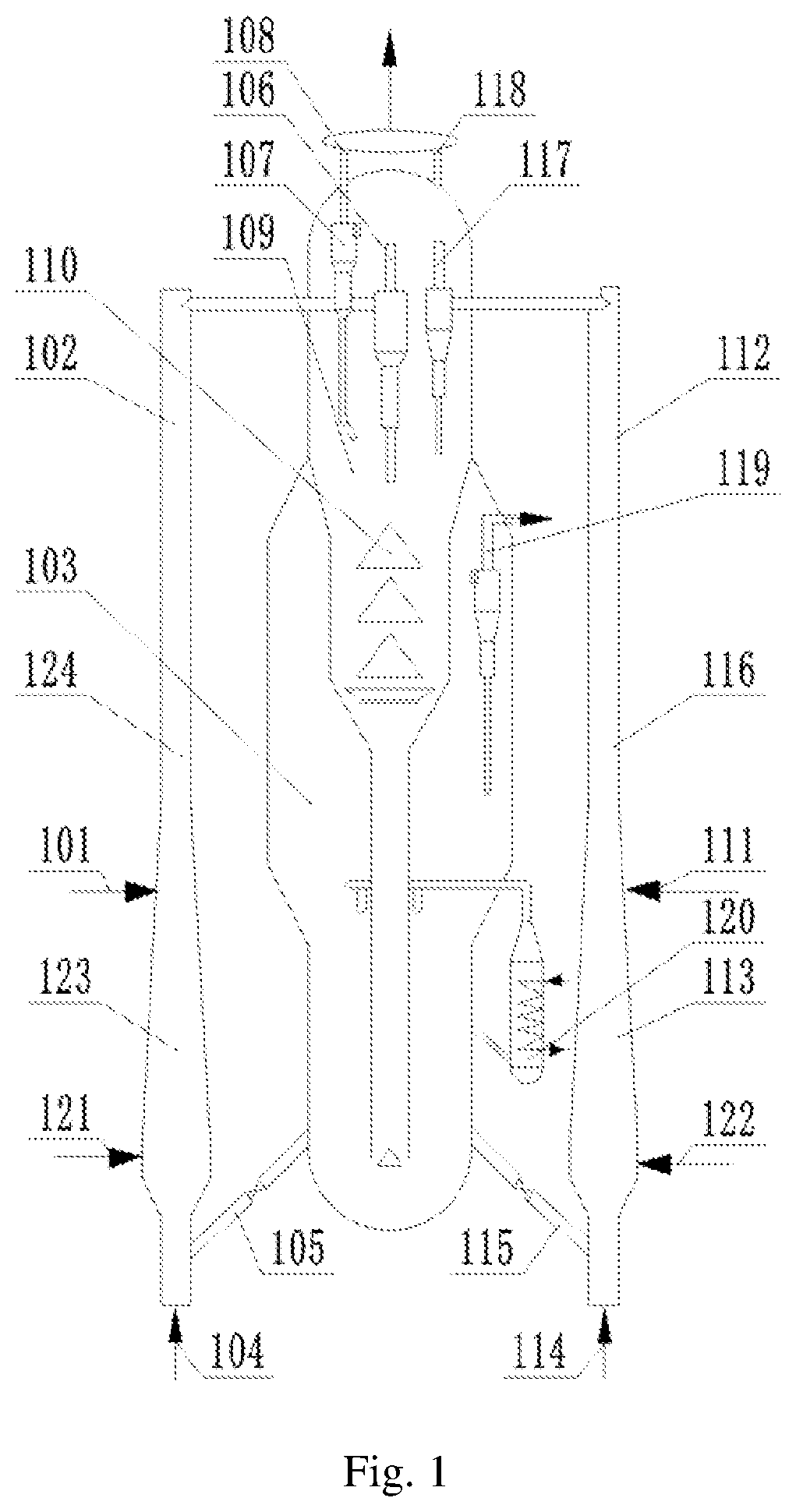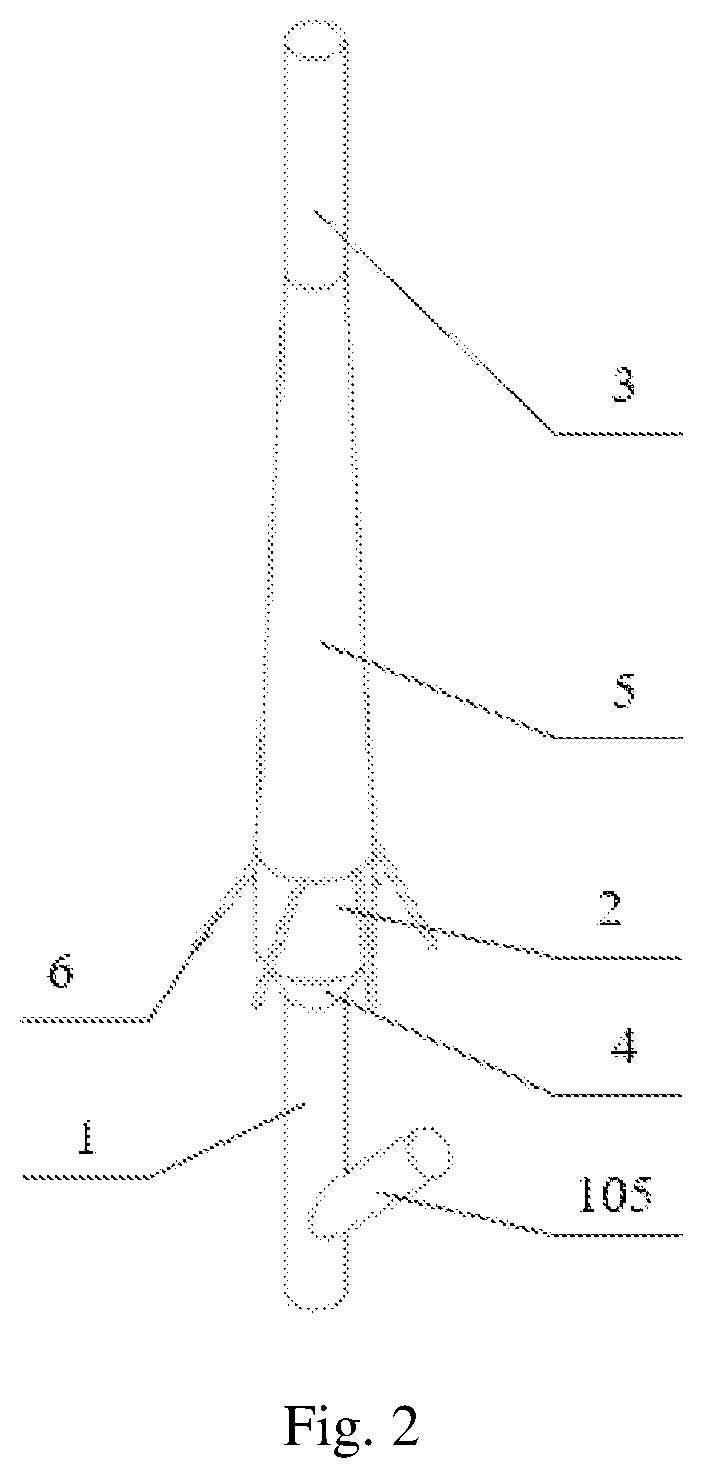Method for producing chemicals from crude oil by double-tube parallel multi-zone catalytic conversion
a technology of catalytic conversion and double-tube, which is applied in the field of petroleum processing, can solve the problems of low technological progress, high energy consumption, and difficulty in greatly increasing the yield of propylene as the main by-produ
- Summary
- Abstract
- Description
- Claims
- Application Information
AI Technical Summary
Benefits of technology
Problems solved by technology
Method used
Image
Examples
embodiment 1
[0039]A riser reaction tube with swirl feed structure is taken as an example in the embodiment. After desalination and dehydration, the crude oil is separated into light components and heavy components by boiling points through a flash evaporation or distillation process. Fractions lower than 200° C. are light components, and fractions higher than 200° C. are heavy components.
[0040]Referring to the schematic diagram of a process flow and a device shown in FIG. 1, a light alkane 121 is injected from a lower portion of a first riser reactor 102 for contact and reaction with a high temperature regenerated catalyst delivered by a regenerator inclined tube 105 from a regenerator 103 and raised by a pre-rising steam or a rising dry gas 104. After reaction at 600-800° C. under a pressure of 0.1-0.4 MPa with a ratio of catalyst to oil of 5-30 for 0.1-5.0 s, the reaction product leaves a light alkane reaction zone 123 and enters a first heavy oil reaction zone 124. At the bottom of the first...
embodiment 2
[0041]A riser reaction tube with swirl feed structure is adopted, and the crude oil is fed directly.
[0042]Referring to the schematic diagram of a process flow and a device shown in FIG. 1, a light alkane 121 is injected from a lower portion of a first riser reactor 102 for contact and reaction with a high temperature regenerated catalyst delivered by a regenerator inclined tube 105 from a regenerator 103 and raised by a pre-rising steam or a rising dry gas 104. After reaction at 600-800° C. under a pressure of 0.1-0.4 MPa with a ratio of catalyst to oil of 5-30 for 0.1-5.0 s, the reaction product leaves a light alkane reaction zone 123 and enters a first heavy oil reaction zone 124. At the bottom of the first heavy oil reaction zone, the reaction product is mixed with the crude oil 101 preheated to 150-250° C. for reaction at 500-700° C. under a pressure of 0.1-0.4 MPa with a ratio of catalyst to oil of 5-30 for 0.1-5.0 s, then the reaction product enters a gas-solid separator 106 a...
embodiment 3
[0043]A downer reaction tube with swirl feed structure is adopted. After desalination and dehydration, the crude oil is separated into light components and heavy components by boiling points through a flash evaporation or distillation process. Fractions lower than 200° C. are light components, and fractions higher than 200° C. are heavy components. Refer to Embodiment 1 for the specific process.
PUM
| Property | Measurement | Unit |
|---|---|---|
| Temperature | aaaaa | aaaaa |
| Temperature | aaaaa | aaaaa |
| Temperature | aaaaa | aaaaa |
Abstract
Description
Claims
Application Information
 Login to View More
Login to View More - R&D
- Intellectual Property
- Life Sciences
- Materials
- Tech Scout
- Unparalleled Data Quality
- Higher Quality Content
- 60% Fewer Hallucinations
Browse by: Latest US Patents, China's latest patents, Technical Efficacy Thesaurus, Application Domain, Technology Topic, Popular Technical Reports.
© 2025 PatSnap. All rights reserved.Legal|Privacy policy|Modern Slavery Act Transparency Statement|Sitemap|About US| Contact US: help@patsnap.com


